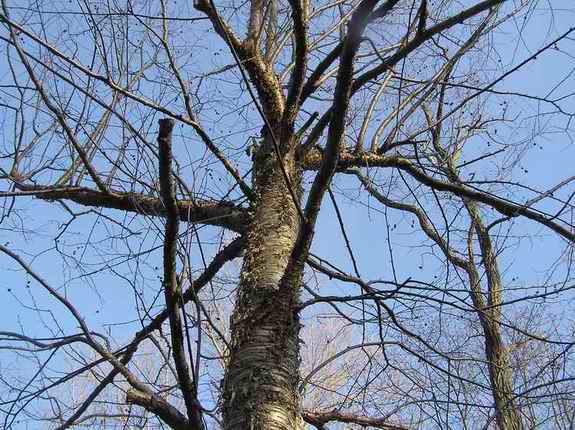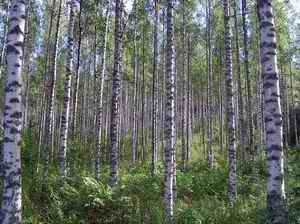|
Return to Hiker's Notebook Home Page
Common Name: Yellow Birch, Gray birch, Silver birch, Curly birch, Swamp birch Paper birch - Birch comes from the Old English word beorht which means bright, probably referring to the striking visual effect of the white boles of the trees against the dark background of the forest. Yellow is the color of the autumnal carotenoid hue of birch leaves in general; those of the yellow birch are particularly vivid. The exfoliating bark sometimes has a yellowish hue and the wood tends toward a yellow-brown coloration. It is not clear whether the name Yellow birch refers to the leaves, the bark or the wood. Perhaps all three.
Scientific Name: Betula alleghaniensis - Betula is the Latin word for birch tree and is used here to refer to the genus; it is derived from the Gaulish word betu which means bitumen, an asphalt tar from Asia Minor. The syllogism is that the dark sap of the birch tree looks like bitumen. The species name alleghaniensis was assigned by Nathanial Britton, the first director of the New York Botanical Garden, to indicate that the tree is endemic to the Allegheny Mountains. Also known in some texts as B. lutea, from the Latin lutum, a plant used to make yellow dye.
Birch trees have smooth, resinous bark that is characterized by circumferential lines punctuated by markings called lenticels, pores that allow for the aeration of the trunk of the tree. The bark of most birch trees (black birch or sweet birch and water birch excepted) is divided into thin, layered sheets that can be peeled horizontally from the tree, giving the tree a somewhat shredded appearance. These hirsute species are differentiated according to geographic latitudinal preference and color; the most notable are the paper or white birch (B. papyrifera) prevalent in the boreal forests of North America, and the European white birch (B. pendula) in the corresponding regions of Eurasia. Birches are hardy pioneer plants that were among the first species to become established as the glaciers receded at the end of the Pleistocene Epoch 10,000 years ago. In these northern reaches, white birches can occupy almost pure stands, their trunks in stark contrast to the surrounding woods, the overall effect one of chiaroscuro. Further south, yellow birch trees compete with other hardwoods such as oak and beech and exist mostly in isolated stands. The popularity of the yellow and white birch is evident in the nascent culture of North America. Henry Wadsworth Longfellow's "The Song of Hiawatha" attests to this:
Give me your bark, O Birch-tree! Or your yellow bark, O birch tree I a light canoe will build me White Birch Forest in Finland That shall float upon the river
The bark of yellow and paper birch trees was employed by Native Americans in a wide variety of innovative applications ranging from watercraft to wigwams. The paper birch is also known as the canoe birch, the provenance of the caricatured birch bark canoe; yellow birch was also used for canoes by Indians in more southern geographic homelands. The pliability of the bark allowed it to be molded onto a frame of cedar and sealed with spruce resin. Wigwam dwellings were made of yellow birch saplings that were arranged in a circle, bent inward and fastened at the center to form a dome and covered with strips of bark for shelter. Since the bark was lightweight and flexible, it was also fashioned into buckets, trays, eating vessels and even cooking pots, the edges sealed with pine pitch or spruce resin. It was even used in burial ceremonies as a means of cleansing the dead and fabricated into noise-making trumpets to attract game, an Indian version of the moose call.
The versatility of the birch tree was manifest in many other cultural applications. It was used by both Native Americans and Eurasians as a means for graphic communication; the name paper birch therefore applies not only to the laminar structure of the bark but also to its use. It's paper-like versatility was adapted to the fabrication of stencils for decorating other objects and beadwork. The flammability of birch bark even when wet made it an excellent tinder for fire initiation; when rolled into a cylinder placed atop a pole, it provided illumination for nocturnal activities, notably night fishing. In the Lapland areas of northern Finland and most probably in North America, the bark was used as an emergency source of food in times of famine. Both the yellow and the paper birch produce a sap similar to that of the sugar maple. However, it is much more difficult to make birch syrup; it takes about 100 liters of sap to make 1 liter of syrup (twice as much as maple); birch sap cannot be boiled for reduction since it is mostly fructose, which, unlike the sucrose based maple syrup, is temperature sensitive. The sap was consumed directly as a beverage , or, when converted to syrup, as a sweetener additive to medicines as a means to alleviate acerbity.
Birch bark contains betulonic acid and betulin, compounds that have long been thought to have potential implications for anti-viral, anti-inflammatory and anti-cancer treatments. Over the last several decades, research at the U. S. National Cancer Institute has demonstrated that betulonic acid is effective in the eradication of breast and lung cancer cells. Experiments with male mice transplanted with human prostate cancer cells and treated with injections of betulonic acid exhibited a 92 percent reduction in the growth of tumors. However, practical use of betulonic acid in treatment was not possible until last year when scientists at the Weill College of Cornell University in New York City devised a process to make it water soluble. It is likely that human treatments for cancer derived from birch bark betulonic acid will soon be developed.
The use of birch bark and birch sap in traditional folk remedies lends credence to its potential as a viable medication; its specific uses varied according to tribal custom. Some Native American tribes used a decoction of the inner bark to treat constipation. Others used the bark as a cleansing agent for intestinal bile and for blood purification; ritual purification was routinely practiced by many tribes as a matter of high cultural significance. The Iroquois used a bark tea to treat skin rashes and the Mi'kmaq heated the bark to apply to sore joints and muscles like a compress. Colonists adapted the use of birch sap from the Indians and used it to prevent scurvy and as a laxative. The black fungus that grows on birch trees known as Chaga thought to derive is healing properties at least in part from the uptake of betulin from the bark.
Yellow birch was once one of the premier woods for the manufacture of tools and equipment that needed to be tough and fracture resistant. Traditional Native American uses included spear shafts, bows, arrows, and, further north, sledges and snowshoes. When the veneering process was first developed in the middle of the 19th Century, the finely grained rose-yellow wood of the yellow birch proved to be ideally suited for cabinetry. The tough flexibility of the yellow birch wood was also used for everything from yokes to cart wheel hubs. Yellow birch was the premier wood of the shipbuilding industry in Canada and was particularly favored for the keel, the stem and the planks. Though it is still used extensively in furniture manufacture today, it is mostly used for mundane products like toothpicks, dowels, and clothespins.
Yellow birch trees produce inordinately large numbers of seeds, ranging from 5 million per acre up to as many as 36 million per acre in a mast year. The high number is offset by the small size; each seed weighs about 10 milligrams. This ensures that the wind will disperse some of them at least 100 meters from the edge of the hardwood stand. This is necessary because birch seeds rarely germinate in hardwood leaf litter, preferring mossy logs, decayed wood and even cracks in rocks, anything that affords an offset from the forest floor. It is not uncommon to see yellow birches on elevated roots that were once elevated on now rotted stumps. They are known as prop roots. |

